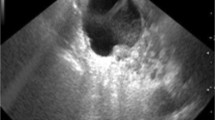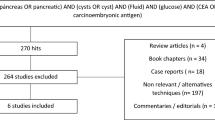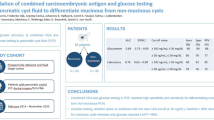Abstract
Current management of intraductal papillary mucinous neoplasm (IPMN) according to recently published International Consensus Guidelines depends upon distinguishing it from mucinous cystic neoplasms (MCNs). We have previously shown that prostaglandin E2 (PGE2) is increased in pancreatic cancer tissue over normal controls. Thus, we hypothesized that PGE2 level in pancreatic fluid differentiates IPMN and MCN and is a biomarker of IPMN dysplasia. Pancreatic fluid was collected in 65 patients at the time of endoscopy (EUS or ERCP) or operation (OR) and analyzed by PGE2 enzyme-linked immunosorbent assay (ELISA). PGE2 level was correlated with surgical pathologic diagnosis and dysplastic stage. Mean PGE2 level (pg/μl) in IPMNs (2.2 ± 0.6) was greater than in MCNs (0.2 ± 0.1) (p < 0.05). Mean PGE2 level of IPMN by dysplastic stage was 0.1 ± 0.01 (low grade), 1.2 ± 0.6 (medium grade), 4.4 ± 0.9 (high grade), and 5.0 ± 2.3 (invasive). Among invasive IPMN, PGE2 level dropped in advanced cases with pancreatic ductal obstruction by tumor (0.3 ± 0) vs non-obstructed (8.6 ± 2.9). PGE2 level may help in distinguishing IPMN from MCN in patients with known mucinous lesions. PGE2 level may also be an indicator of malignant progression of IPMN before ductal obstruction by tumor. Prospective evaluation will be necessary to evaluate the clinical role of PGE2 level in pancreatic fluid.






Similar content being viewed by others
References
Tanaka M, Chari S, Adsay V, Fernandez-Del Castillo C, Falconi M, Shimizu M, Yamaguchi K, Yamao K, Matsuno S. International consensus guidelines for management of intraductal papillary mucinous neoplasms and mucinous cystic neoplasms of the pancreas. Pancreatology 2006;6(1-2):17–32.
Schmidt CM, Wiesenauer CA, Cummings OW, Yiannoutsos CT, Howard TJ, Wiebke EA, Goulet RJ Jr, McHenry LH, Sherman S, Lehman GA, Cramer H, Madura JA. Preoperative predictors of malignancy in pancreatic intraductal papillary mucinous neoplasms (IPMN). Arch Surg 2003;138:610–618.
Crowell PL, Schmidt CM, Yip-Schneider MT, Savage JJ, Hertzler DA, Cummings WO. Cyclooxygenase-2-expression throughout hamster and human pancreatic neoplasia. Neoplasia 2006;8(6):437–445.
Schmidt CM, Lillemoe KD. IPMN—controversies in an “epidemic”. J Surgical Oncology 2006;94(2):91–93.
Salvia R, Fernandez-del Castillo C, Bassi C, Thayer SP, Falconi M, Mantovani W, Pederzoli P, Warshaw AL. Main-duct intraductal papillary mucinous neoplasms of the pancreas: clinical predictors of malignancy and long-term survival following resection. Ann Surg 2004;239(5):678–687.
Sohn TA, Yeo CJ, Cameron JL, Iacobuzio-Donahue CA, Hruban RH, Lillemoe KD. Intraductal papillary mucinous neoplasms of the pancreas: an increasingly recognized clinicopathologic entity. Ann Surg 2001;234:313–322.
Sohn TA, Yeo CJ, Cameron JL, Hruban RH, Fukushima N, Campbell KA, Lillemoe KD. Intraductal papillary mucinous neoplasms of the pancreas: an updated experience. Ann Surg 2004;239(6):788–799.
Chari ST, Yadav D, Smyrk TC, DiMagno EP, Miller LJ, Raimondo M, Clain JE, Norton IA, Pearson RK, Petersen BT, Wiersema MJ, Farnell MB, Sarr MG. Study of recurrence after surgical resection of intraductal papillary mucinous neoplasm of the pancreas. Gastroenterology 2002 ;123(5):1500–1507.
D’Angelica MD, Brennan MF, Suriawinata AA, Klimstra D, Conlon KC. Intraductal papillary mucinous neoplasms of the pancreas. Ann Surg 2004;239(5):400–408.
Spinelli KS, Fromwiller TE, Daniel RA, Kiely JM, Nakeeb A, Komorowski RA, Wilson SD, Pitt HA. Cystic pancreatic neoplasms: observe or operate. Ann Surg 2004;239(5):651–659.
Author information
Authors and Affiliations
Corresponding author
Additional information
Discussion
Nipun B. Merchant, M.D. (Nashville, TN): Max, that was an excellent presentation, and I congratulate you on presenting this very compelling data that can potentially diagnose and distinguish IPMNs from other mucinous neoplasms. This assay clearly has the capability of having immediate clinical impact on the management of these patients. It is good to see from the previous talk and this one that we are beginning to understand these lesions better.
Based on your findings that PGE2 levels were increased in pancreatic adenocarcinomas, I think it is logical to assess PGE2 levels in cyst fluid. Based on this, I have several questions.
There is always a concern about using PGE2 as a biomarker, as it is a significant biomarker of any inflammatory condition. So are you concerned that you may just be assessing an increase in inflammation, as these tumors progress from low grade dysplasia towards an invasive phenotype? Have you correlated the cyst levels of PGE2 to actual tissue levels as you did with your pancreatic ductal adenocarcinomas? To extrapolate from your question on a previous talk, can you distinguish main duct lesions, that is, is there a difference in PGE2 levels from main duct lesions and side branch lesions? I did not see in your talk if you were able to distinguish mucinous cystadenomas with mucinous cystadenocarcinomas based on differences in PGE2 levels.
The other interesting thing I noticed is that your PGE2 levels in the invasive IPMNs were significantly higher than PGE2 levels seen in pancreatic adenocarcinoma. Can you speculate as to why that might be?
Lastly, I wanted to end on a comment. Last year at this meeting, we presented data showing that urinary PGE-M, which is a urinary metabolite of PGE2, could be a potential biomarker in pancreas cancer, as it is significantly elevated in patients with cancer compared to normal controls. It seems as though this urinary biomarker might be ideal to evaluate in these patients to determine progression of disease or even following them for potential recurrence of disease.
Thank you for this excellent presentation.
C. Max Schmidt, M.D. (Indianapolis, IN): Thank you, Dr. Merchant, for your excellent questions. In response:
1. Inflammation: We believe that PGE2 may be a biomarker of chronicity of disease. Inflammation/pancreatitis and other evidences of chronicity, e.g., exocrine/endocrine pancreatic insufficiency, may correlate with PGE2 level and ultimately dysplastic state. PGE2 level in pseudocysts/pancreatitis will undoubtedly have overlap with PGE2 levels in dysplastic IPMN. Therefore, to clarify, this study is limited to known mucinous lesions. Thus, we envision application of PGE2 as a biomarker in patients with a fairly certain diagnosis of a mucinous lesion, i.e., mucinous cyst CEA >200 ng/ml, cytology consistent with mucinous epithelium, or multifocal cysts consistent with multifocal side-branch IPMN. In other words, PGE2 should not be used to distinguish chronic pancreatitis from mucinous cystic lesion of the pancreas.
2. PGE2 tissue levels correlate? We have not measured PGE2 level in pancreas tissue of progressive stages of IPMN dysplasia and correlated this with PGE2 level in pancreatic cyst fluid. We have, however, looked at cyclooxygenase-2 expression, and this mirrors PGE2 level in pancreatic cyst fluid.
3. Side branch vs main duct IPMN? Mucinous cystadenoma vs mucinous cystadenocarcinoma? This study was conceived as a side-branch IPMN study. Pancreatic cyst fluid samples on side branch invasive cancers, however, are uncommon. Thus, in this study, a significant number of invasive cancers are main type, whereas the other dysplastic IPMN are side branch type. Pancreatic cyst fluid on mucinous cystadenocarcinoma fluid was not available. These are limitations of the study which will only be remedied as we collect more of these precious samples to study through our own efforts or collaboration with others.
4. Why invasive IPMN has a higher PGE2 level than ductal adenocarcinoma? Statistically, they are not different.
Mark P. Callery, M.D. (Boston, MA): What could be the cellular source of PGE2 in these lesions?
Dr. Schmidt: Great question. Pancreatic cyst fluid when pelleted has a variety of cells including ductal epithelium, IPMN cells, inflammatory cells, hematopoietic cells, and supportive stromal cells. We are uncertain as to which is the predominant cellular source of PGE2.
Dr. Callery: Have you tried to collect those and propagate them and study them?
Dr. Schmidt: We have tried collecting them and propagating them. We have been able to achieve attachment of IPMN cells but have been unable to successfully passage them to date.
L. William Traverso, M.D. (Seattle, WA): Dr. Schmidt, your results are very provocative and made me think a little bit more about the problem we have in the practical sense of mucinous cystic neoplasms vs IPMNs. I would follow Dr. Callery’s question and ask you what cell produces PGE2? Is it possible that PGE2 is not present inside an obstructed duct or cyst? A MCN may not have PGE2 because there is no duct for it to communicate with and that the cell of origin may be atrophied in the ductal obstruction. The pathologist will not make a diagnosis of mucinous cystic neoplasm in the head of the pancreas in a man because there is no ovarian stroma. You will never see one made in a man. So any cystic neoplasm in the head with or without a ductal connection will not help the pathologist diagnose MCN. If there is no ovarian stroma, it will not be called a mucinous cystic neoplasm. Therefore, the pathologist could really use a biomarker in their classification system as they are trying to do with the new version of the AJCC staging system.
So my question would be if PGE2 could be seen in the wall in an immunohistochemical study in an IPMN and it was also not seen in the wall of a MCN, it would further help them make a diagnosis. We will never see a mucinous cystic neoplasm in the head of the pancreas with the current classification. So this is really an assistance to the pathologists. The next time they meet in Park City like they did in the mid 1990s to devise the WHO classification, they could use this biomarker as an assistance to help in practical application of it in the future. Do you think you can find PGE2 in the cell?
Dr. Schmidt: Thank you Dr. Traverso. PGE2 immunohistochemistry is being performed by our lab presently, but we have not established optimal conditions to date. We are hopeful that we will determine the cell(s) or origin.
COX-2 (upstream from PGE2) has been characterized via immunohistochemistry in the ductal epithelium of IPMNs and PanINs by our group and others and demonstrates a similar positive correlation with progressive IPMN and PanIN dysplasia.
C. Max Schmidt and Michele T. Yip-Schneider contributed equally to this work.
Grant support: This work was supported by the NIH 1R03CA112629-01A1 (CMS) and Central Surgical Association Enrichment Award (CMS)
Rights and permissions
About this article
Cite this article
Schmidt, C.M., Yip-Schneider, M.T., Ralstin, M.C. et al. PGE2 in Pancreatic Cyst Fluid Helps Differentiate IPMN from MCN and Predict IPMN Dysplasia. J Gastrointest Surg 12, 243–249 (2008). https://doi.org/10.1007/s11605-007-0404-8
Received:
Accepted:
Published:
Issue Date:
DOI: https://doi.org/10.1007/s11605-007-0404-8




